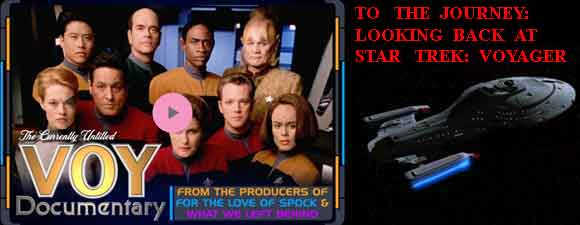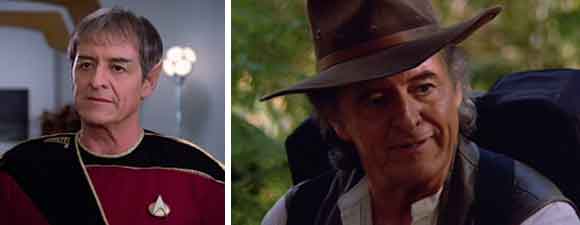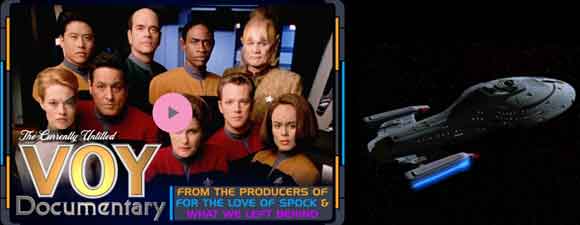Retro Review: Coda
7 min read
codabanner
Janeway is caught in a time loop that ends with her death and the arrival of what appears to be her late father.
Plot Summary: A sudden storm interrupts Janeway and Chakotay’s affectionate banter while they’re alone on a shuttlecraft. The shuttle crashes on a planet, nearly killing Janeway, though Chakotay performs CPR and revives her. Minutes later, the two are attacked and slain by Vidiians, but moments after that, they find themselves back on the shuttle, chatting as if nothing has happened. This sequence of events repeats with variations: the shuttle is blown apart, the captain contracts the Vidiian phage and is euthanized by the Doctor, an anomaly appears on the viewscreen – always ending in Janeway’s death. Finally she observes while Chakotay is unable to revive her with CPR as he did the first time. The crew tries to come to terms with her loss, which some deny because at first Kes believes she can sense Janeway’s consciousness. Janeway tries to find ways to make contact, though she is invisible and can pass through solid matter. The anomaly reappears on the ship, releasing Janeway’s father, who claims to have arrived to demonstrate that she is dead and to help her cross over. Though distressed when Tuvok and Kes stop using telepathy to search for her and wrenched when Chakotay leads a memorial service at which Torres and Kim become emotional, Janeway does not feel ready to move on. When her father pressures and then bullies her to accept her fate, she concludes that he is not a spirit and she is not dead, but fighting for her life while an alien presence tries to draw her consciousness into the anomaly. With the help of the Doctor, she fights off the alien and wakes on the planet. Chakotay advises her to take it easy for a few days, but Janeway is unnerved by the idea that this alien species could be responsible for myths about the afterlife and prefers to celebrate having cheated death, inviting Chakotay to share a bottle of champagne on a holodeck moonlight sail around Lake George with her.
Analysis: Like “Resolutions,” “Coda” makes me so acutely nostalgic that I can’t pretend to review it objectively. If you don’t care about Janeway and Chakotay’s relationship apart from how they interact as a command team, you’ll probably find the episode derivative and somewhat over-the-top, which is fair. The script borrows from several previous Star Trek installments, the guest star is too menacing to take seriously as a benevolent force, and can anyone imagine Riker sobbing over Picard’s body, let alone Spock sobbing over Kirk’s? Feel free to discuss in comments how the afterlife in “Coda” isn’t nearly as compelling as the one in “Emanations” and how much more fun it would be to meet Q from “Tapestry” upon your presumed death rather than to meet Janeway’s father. Also feel free to discuss how “Cause and Effect” did the time loop story better, how “The Tholian Web” did the ghost captain better, how The Wrath of Khan did the memorial service better, and whether it’s logical that some idiot – probably Lewis Zimmerman – actually programmed the EMH to be capable of performing euthanasia on an unwilling patient without requiring a second opinion, in which case the first thing Janeway does upon recovery should be to disable that option, since the sickbay gas chamber should be the first obvious giveaway that she isn’t in a time loop but being manipulated by an alien. These are all valid concerns about the story, but they aren’t what I want to discuss. All I’ve ever remembered about “Coda” is the phenomenal chemistry between Janeway and Chakotay…the way they make each other laugh, the way they casually use first names and touch when no one else is looking, the way they flirt. The way they adore each other. If you disagree, then come up with one other valid reason for them to go on potentially dangerous away missions together just so they can have some alone time.
“Coda” is a direct sequel to “Resolutions” as well as “Future’s End” and “The Q and the Grey” – all episodes in which we see how well Janeway and Chakotay work together, that they complement and challenge one another in addition to keeping each other comfortable and relaxed. These little things are of crucial importance in the jobs they’ll likely have to keep for many years without any hope of sabbaticals or even significant down time. As enjoyable as it is to watch them falling in love in a desert island scenario in “Resolutions,” I find “Coda” preferable because this is real life for them, working in jobs they chose and for which they trained. It’s not like there’s no one else on board with whom Janeway can share a chuckle about Talent Night, since we see her doing just that with Neelix before she gets on the shuttle with Chakotay. It’s the way she brushes off Neelix’s compliment about her dubious ballet skills, even though that dialogue is written to sound teasing and naughty (“Captain, you were especially good last night.” “Thanks, Neelix. It’s been a while.”), whereas when Chakotay announces that the highlight of his evening was watching Kathryn Janeway portraying the dying swan, she glows even as she insists that she dances like a six-year-old. The two seamlessly segue from Janeway’s suggestion that they could perform together at the next Talent Night to working in tandem to avert a crisis. No one watching this episode is really worried about whether the two will survive, considering that they’re series regulars – we even know better than to worry about the destruction of the shuttlecraft, since Voyager apparently has several thousand. All the power of the opening scenes comes from the dynamic between Janeway and Chakotay, the way she responds when he can’t remember the time loop, the way he reacts when he believes he’s lost her. As in “Dreadnought,” he lets her go when he must, but oh, it hurts.
Because it’s stranded in the Delta Quadrant, Voyager is in a tough situation – and yes, I mean the show, not just the ship. With the other series, there are a lot of big issues to engage the passions of the characters. There’s a Federation to defend, there are Starfleet institutions as well as regulations that sometimes come up against the moral codes of individuals, there are alien adversaries who live nearby and must be dealt with as permanent threats, plus there are families and friends close enough for occasional or even regular visits whether it’s Troi’s meddling mother or Sisko’s Earth-bound father. On Voyager, even still-living relatives might as well be ghosts – they only show up in memories, holograms, alien hallucinations – and there are no species like the Klingons or the Dominion who must be dealt with as permanent fixtures. Starfleet principles like the non-interference directive must be addressed and interpreted without the support and oversight of admirals and diplomats. Apart from a Kazon arc here and a Borg sequence there, nearly all the connections on this show must be among the regular characters, many of whom, like Carey and Ayala, never become much more than repeated faces in specific jobs. Given these storytelling constraints, the most interesting relationships are also the most complicated. There’s none with greater potential than the captain and first officer, a dynamic that inevitably includes professional conflict and divided loyalties. Throw things like love and commitment into the mix, and we’d finally get a relationship to rival all the beautiful, complex bonds on Deep Space Nine between people in situations just as complicated – a Starfleet captain and a Maquis rebel, a solid Bajoran and a shapeshifting Founder, a Trill who’s an honorary Klingon and a Klingon who was raised by humans.
It never happens, of course. In a couple of weeks we get the first installment in what will become Chakotay’s long history of falling for aggressive Borg women, and we get even more indications that Janeway’s not capable of sharing her responsibilities since she becomes overly emotional and locks herself away when challenged. This isn’t either character’s fault – it’s the writing – and it’s not the fault of Kate Mulgrew or Robert Beltran, who are clearly giving their all in “Coda” both in what look like effortless lighthearted moments and in the dark emotional scenes. Beltran’s the one who gets to cry, a powerful contrast to the glorified “emotionless” men of the Star Trek franchise, but Mulgrew has more screen time and a broader range to portray as Janeway slowly realizes that she’s being manipulated by an alien who can access her private memories. Presumably the alien shows Janeway people mourning her the way she’d wish to be remembered, so the lovely speech Torres gives at her memorial service about what she learned from the captain represents Janeway’s attachment to Torres as much as the reverse. Which means that we’re not necessarily seeing how Chakotay would act upon Janeway’s death, but how she hopes he would act. In some ways “Coda” seems like a remix of “Persistence of Vision,” also written by Jeri Taylor, since this time Janeway refuses to succumb to an evil alien impersonating a loved one. She fights to keep her ship and doesn’t spare a single thought for the man on Earth she’ll presumably never see again. Janeway may never fully believe in the evil alien impersonating her father, a beloved figure miraculously returned to life, but I know how she feels, because except for a brief interlude in the final season flashback episode “Shattered,” we never fully recover this version of Janeway and Chakotay, and it’s hard to let go.






